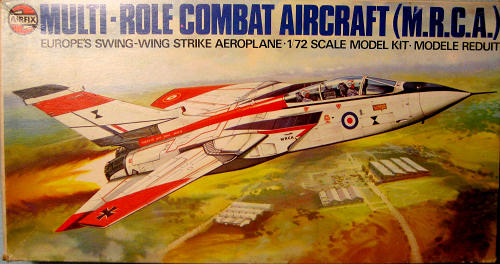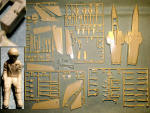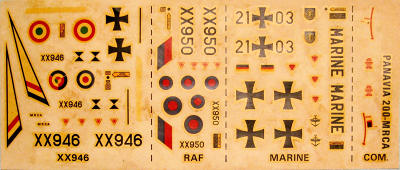
Airfix 1/72 MRCA (Tornado)
| KIT #: | 04019 |
| PRICE: | HK$80 at UML in Mong Kok |
| DECALS: | Three options |
| REVIEWER: | Richard F |
| NOTES: | Airfix's kit of the prototype of the Panavia Tornado |

| HISTORY |
When I was a kid, my grandmother subscribed me to a cool magazine called
"Insights". It gave this wide-eyed kid an insight into the future of technology.
You know, the usual stuff: mining colonies on the moon, jetliners that could
land themselves, computers that fit on a single table...
One issue described an incredible new two-man "swing-wing" aircraft that could
fly at very low level, faster than the speed of sound, and deliver a precision
attack against a heavily defended Soviet target. No doubt you're guessing I grew
up in the early 60s and I'm talking about the F-111. Well, no. I grew up in the
early 80s and I'm talking about the Panavia MRCA Multi-Role Combat Aircraft.
F-111s were in already in combat in Vietnam not long after the MRCA project was
defined and the three national partners, Germany, Italy and the UK signed the
Intention to Proceed. The F-111 was attacking Libya as the Tornados were
becoming fully operational. By the time the Gulf War came along, F-111s and
Tornados were both flying missions in Iraq, the F-111s on their swansong, the
Tornados with many years service ahead.
But the fact it now seems a little behind the times didn't stop me at the time
from thinking "Man that's a Really Cool Aeroplane". I still think so. Tornados
may not be the prettiest, or the most capable, but when you see one rip past at
low level, in person or even on a youtube clip from RAF valley, they are
suitably fast and noisy and impressive.
Cynics say MRCA really meant "Must Replace Canberra...Again". Many people know
of the trials and tribulations the UK had to replace its Canberra bombers -
there was the TSR2, the F-111, and even the Buccaneer which served in a land
support role in Europe despite being designed for maritime strike. The Tornado
finally came into service in the early 1980s.
The Tornado prototype XX946, depicted on the box art, was actually the second
airframe. Later it was painted in a typical RAF green-grey camouflage and
retired to RAF Cosford museum. Those with eagle eyes will notice the decal sheet
describes the aircraft as the Panavia 200. There was an early plan for a single-seater
Panavia 100 which apparently never made it off the drawing boards.
| THE KIT |
 This
kit apparently came out in 1976, though mine is copyrighted 1975. Had I not been
four years old, I am sure I would have snapped it up new. By the time I was
building models this had been retooled to the GR1 version (thanks Airfix Tribute
Forum for that information). There are some subtle differences to the airframe
between the prototype and the series versions.
This
kit apparently came out in 1976, though mine is copyrighted 1975. Had I not been
four years old, I am sure I would have snapped it up new. By the time I was
building models this had been retooled to the GR1 version (thanks Airfix Tribute
Forum for that information). There are some subtle differences to the airframe
between the prototype and the series versions.
For a 1976 kit, I think this Airfix MRCA is very good. The overall shape looks
right, the fit (from test fitting) seems quite good, the raised detail is
subtle, and there are both instrument panels and side consoles for both pilot
and navigator (themselves nicely moulded).
Building it will be the real test, of course, but it's as good as many kits from
the 80s and better than many kits available today.
Undercarriage is a little less detailed than we come to expect these days, and
the nose wheel bay is only a millimetre deep.
The swing wing operates, in theory, with an arm that connects the two wings and
slides at an angle inside the fuselage. We'll see how well that works!
This kit comes with an interesting selection of underwing stores. It includes
seven cluster bombs, four Martel anti-radiation missiles, and two Sparrow BVR
AAMs. It has no fuel tanks, no Sidewinders and no underwing ECM pods. For a
model of a plane designed for high speed, low altitude penetration, it strangely
contains no conventional bombs, either, despite the fact the prototypes tested
them.
The suggested loadouts bear little relationship to what Tornados used
operationally, even in the 1980s. For example, the instructions suggest:
RAF strike - four Martels (two underwing, two under fuselage)
RAF/German naval strike - two Martels under fuselage, four cluster bombs (paired
underwing, inner pylons) and two Sparrows (outer pylons)
RAF air defence - two Sparrows, underwing inner pylons
The Tornado, as the MRCA was called once it entered service, carried freefall
bombs during the 80s, or the big underbelly multi-munition pods (RAF JP-233 and
Luftwaffe MW-1). It also usually carried fuel tanks on the inner wing pylons and
ECM pods on the outer ones. German naval versions carried the Kormoran ASM.
Later (during and after the Gulf War), Tornados (RAF ones, at least) were more
commonly seen with laser guided bombs, massive Zeppelin-sized "Hindenburg"
tanks, and ALARM missiles. Into the future, Tornados will carry Storm Shadow
cruise missiles for stand-off attacks until they are finally replaced by the
Eurofighter.
And, of course, Airfix's concept of the MRCA's air defence mission didn't
translate into the strike version of the Tornado. Instead, the F3 interceptor
was developed, which carried four Sky Shadows and four Sidewinders, rather than
the meagre pair of Sparrows proposed here.
The decals look like they were printed in register, but after all this time
they're yellowed quite badly and I'll need to find replacements. Just about
everything on the sheet is easily found in other RAF or modern Luftwaffe kits.
| CONCLUSIONS |
A fun kit from way back when. I wonder if it was snapped up by people in the same way that new releases are these days, only to sit unbuilt for more than 30 years? Well, I am building mine!
| REFERENCES |
http://www.tornado-data.com/index.html
wikipedia
Airfix Tribute Forum
January 2010
If you would like your product reviewed fairly and quickly, please contact me or see other details in the Note to Contributors.